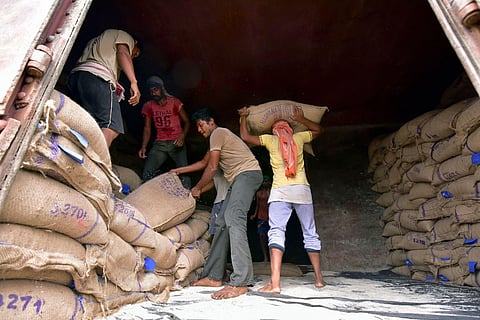

HYDERABAD: The RBI announced another raft of measures to cut the Gordian knot tied up by the COVID-19 pandemic.
The central bank's Friday whopper evenly covered four aspects including liquidity, credit flow, and easing of stress among financial institutions and markets.
The highlights include a 25 bps (0.25%) cut in reverse repo rate, a Rs 50,000-crore targeted long term repo operation (TLTRO), suspension of the 90-day NPA norm for banks, a Rs 50,000-crore special finance window for NABARD, SIDBI and National Housing Board, extension of the ways and means advances to states by up to 60 per cent, exemption for banks from paying dividends and others.
The reverse repo rate has been reduced by 25 bps to 3.75 per cent. The move is expected to discourage banks from sitting on cash and instead encourage them to go out and lend. The surplus liquidity under the reverse repo window stood at Rs 6.9 lakh crore as on April 15. However, other policy tools such as the marginal standing facility, bank rate remain unchanged at 4.65 per cent.
Governor Shaktikanta Das also announced another targeted long term repo operation of Rs 50,000 crore in tranches to ensure that even NBFCS and MFIs have access to liquidity. According to Das, the proposed Rs 50,000 crore is only a beginning and the RBI will not budge from releasing additional tranches based on the need.
The funds will be made up in bonds, commercial paper, NCDs etc with 50 per cent going to small and mid-size NBFCs as the TLTROs until now have been parked in public banks and big corporates while NBFCs were facing hardships.
He also announced a special finance facility to NABARD, SIDBI and National Housing Board totalling Rs 50,000 crore.
Importantly, RBI relaxed the 90-day NPA norm, and advised banks to maintain higher provision to standstill, which can be adjusted later for actual slippages.
"Cashflow of households and businesses are affected. We recognize that COVID-19 has challenged the ability of borrowers to repay. Thus the NPA count shall not include the 90-day moratorium period," he said adding that the relaxation is consistent with Basel guidelines.
According to Das, scheduled commercial banks and financial institutions have to make an additional 20 per cent provision. Due to the challenges of resolutions of accounts, the period of resolution will be increased by a further 90 days.
There was also an extension of the resolution timeline for large accounts under default. An additional provisioning of 20 per cent is required for not implementing a resolution in 180 days and this will be provisioned in the June 7 circular. Banks need to conserve capital and absorb losses, Governor Das said.
As a bonus, RBI exempted banks from making dividend payouts from FY20 until further notice. This will help lenders conserve cash and make up for the provisions in case of rising bad loans.
There was an easing of the liquidity coverage ratio requirement for banks too to ease the liquidity flow for loans given by NBFCs to real-estate companies and relaxation of ways and means advances (WMA) up to 60 per cent until September to states so that they don't bunch their bond issuances and instead space them out. The extension of WMA should come to the states' rescue to make up for the shortfall in cash flows.
Channeling Mahatma Gandhi, Das noted that during our darkest moment, we must focus on the light.
While he noted that the macroeconomic landscape has deteriorated severely in some areas, Das added that India still is among a handful of countries projecting positive growth.
India though will suffer this fiscal, but is expected to rebound sharply in FY2022.